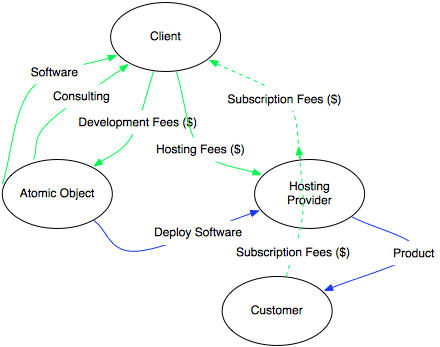We first read about business ecosystems in the Entrepreneur’s Guide to Customer Development.
Over the last year we have added a business ecosystem drawing exercise to our project kickoff practices. This exercise is designed to quickly give our development team a high-level understanding of our client’s business.
A business ecosystem drawing shows high-level value exchanges for the entities that participate in an offering.
To better understand how to draw a business ecosystem, let’s investigate Atomic Object’s simple product development consulting business.
Imagine a client has contracted us to create a web application. The application makes money by collecting a subscription fee from our client’s customer over the web.
The entities in Atomic’s ecosystem are:
- Atomic Object
- Client – our client
- Hosting Provider – we leverage 3rd party hosting providers
- Customer – our client’s customer.
In the drawing there are two types lines. Green lines describe value exchanges and blue lines represent distribution. Dashed lines are used when value is provided in an indirect way (through another entity).
This business ecosystem shows us the following:
- Atomic Object collects development fees from the client in exchange for consulting, software and deployment.
- The client pays the hosting provider for providing the distribution channel to the customer.
- The customer purchases a subscription from the client in exchange for the product. The subscription fees move indirectly through the hosting provider.
After we have completed the ecosystem, we annotate the risks for each entity in the system. It is important to understand these risks because the participation of the entities is vital to the survival of the ecosystem. Long story short, we need to keep all the entities happy if we want our product to work.
Most entity risks fall into the following risk classes:
- Value Risk – Is the product worth it?
- Distribution Risk – Does the channel exist to deliver the product?
- Usability Risk – Is the product easy/fun to understand and use? Can I maximize its value?
Identifying risk classes helps us recommend the correct tactic (user interviews, partnerships, enhanced usability testing, etc.) to mitigate that risk.
When we draw your ecosystem, Atomic Object and the hosting company merge into your entity. We are more interested in how the entities in your ecosystem provide value.
We have found that this simple exercise provides many long-term advantages.
- Creates a shared high-level vision and vocabulary for a product offering.
- Helps the development team to quickly understand the business.
- Facilitates intelligent feature prioritization discussions.
- Helps both the client and development team quickly onboard additional capacity.
- The team is able to map their progress back to how value is being delivered.
- The process of describing the ecosystem and risks helps our client better understand their own business.
Atomic is always looking for new ways to improve our process and provide more value to our clients.
It is important to note that developers are great at optimizing systems. Describing the system to your development team enables them to engage with you in different and valuable ways.


[…] by mapping our product through a mini UX discovery session. The team started by creating a simple business ecosystem so that we all understood the business model and direction. Next, we defined the target users that […]